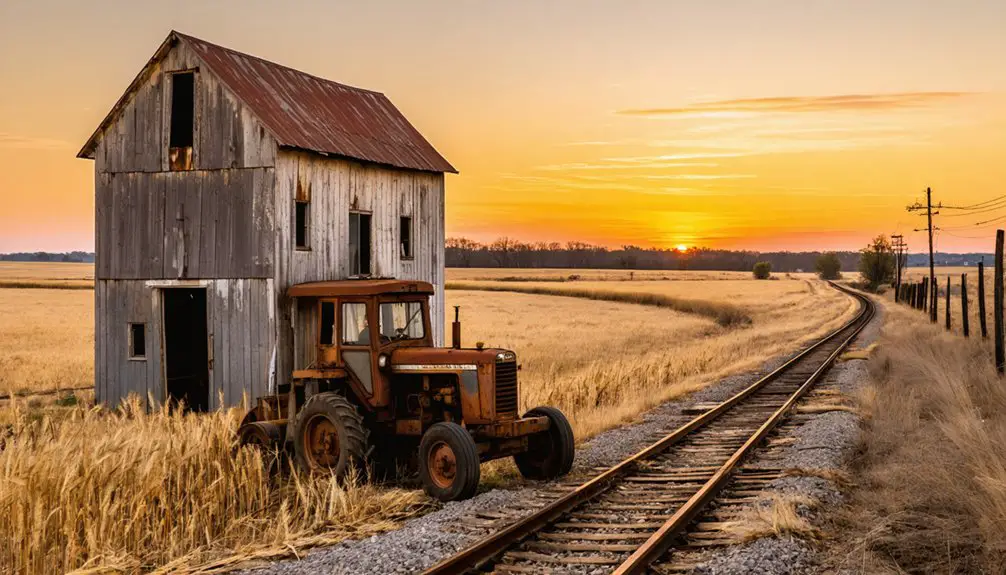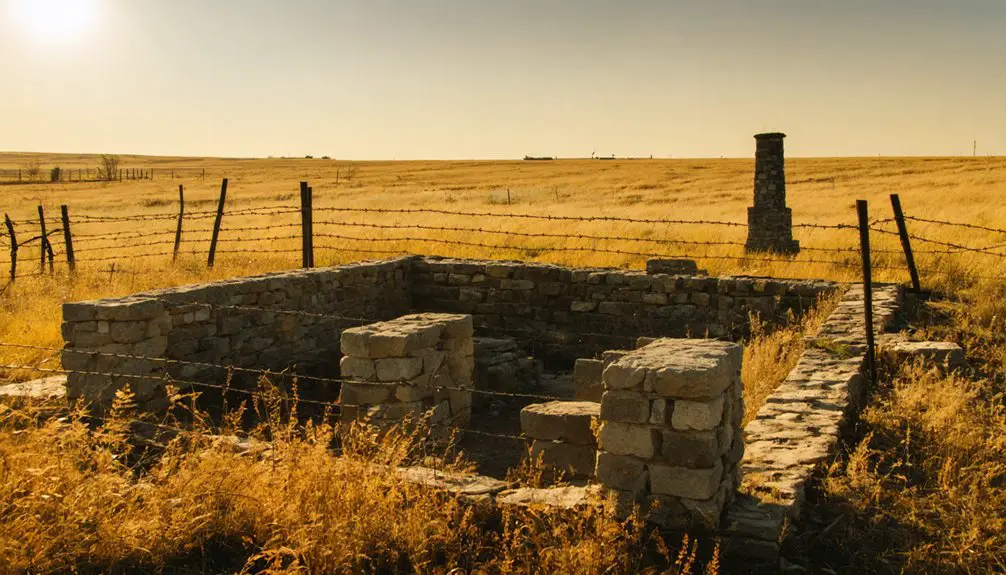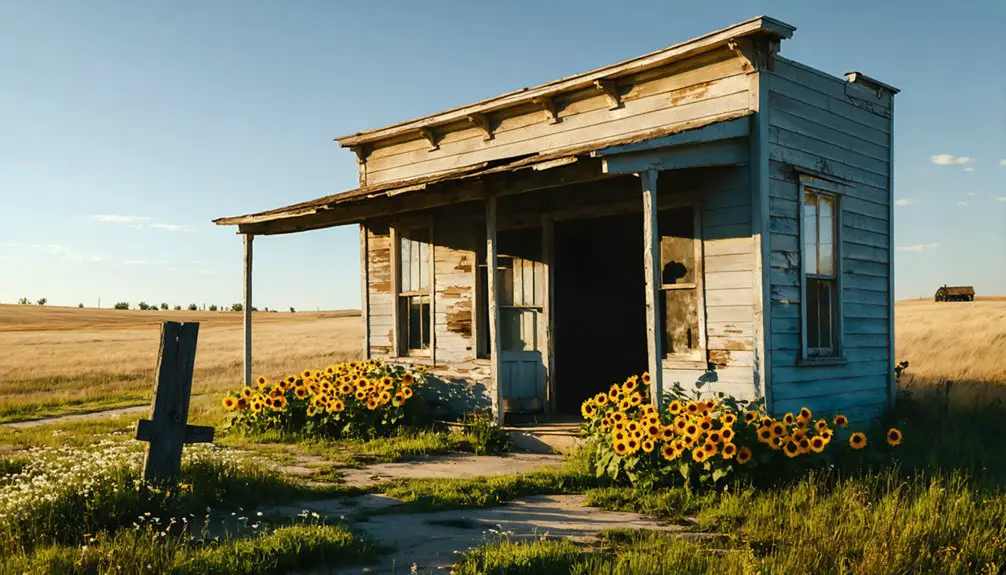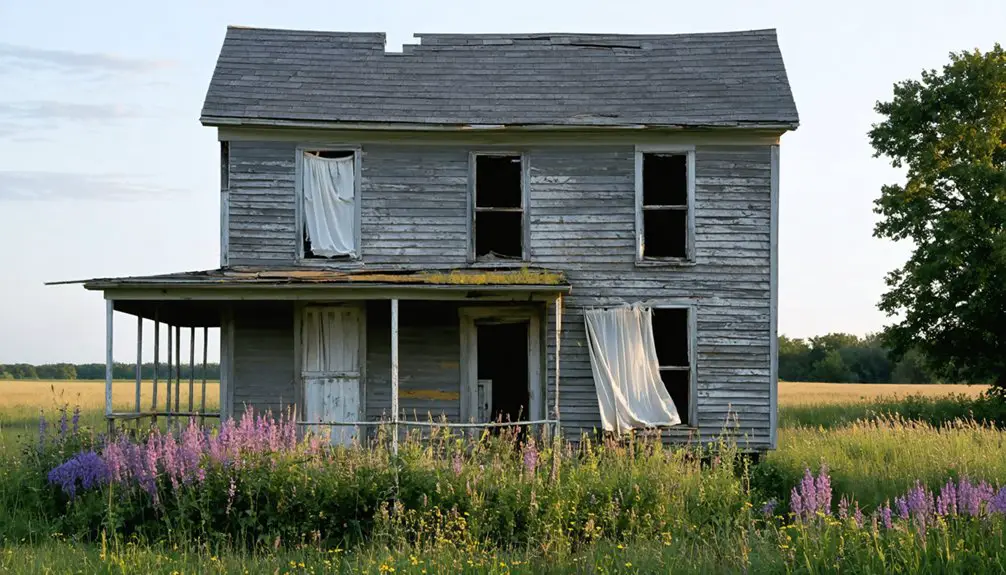You’ll find Calhoun’s haunting remains in Clark County, Kansas, where it once thrived as an agricultural hub in the late 1800s. The town featured a post office, schools, and bustling commerce until devastating droughts and shifting transportation routes led to its decline. By the mid-20th century, the population had dropped 80%, leaving only weathered gravestones, abandoned buildings, and nature-reclaimed streets. The site’s rich history offers fascinating glimpses into Kansas’s pioneering past.
Key Takeaways
- Calhoun experienced an 80% population decline after transportation routes bypassed the town, transforming it from a thriving community into a ghost town.
- The town’s historical buildings, including a brick grocery store and magistrate’s court, now stand abandoned and deteriorating.
- Native grasses, wildflowers, and wildlife have reclaimed the former townsite, obscuring original streets and building foundations.
- Local historical societies preserve Calhoun’s legacy through records, photographs, and educational programs about the ghost town’s past.
- The cemetery’s weathered gravestones chronicle early settler families and community leaders, providing insights into the town’s former prominence.
The Rise and Fall of Calhoun
While frontier settlements dotted the Kansas landscape in the mid-to-late 19th century, Calhoun emerged as a notable community in Clark County.
You’ll find its early community resilience reflected in the establishment of essential institutions, including a post office and schools that served as social anchors for decades.
Like the town of NS Town, Calhoun’s post office was a central feature of its development until the mid-20th century.
Similar to Bell Plane’s apple orchards, agriculture drove the local economy in its early years.
At its peak, the town thrived on agriculture and transportation connections, with a bustling high school operating from the early 1900s through the mid-1960s.
Calhoun reached its zenith as an agricultural hub, anchored by a thriving high school that educated generations from 1900-1960s.
However, the transportation evolution proved devastating when new routes bypassed Calhoun entirely.
You can trace the town’s decline through the dramatic 80% population drop, closure of local businesses, and the shuttering of its school system.
Today, you’ll see only scattered remnants of this once-vibrant community, with most buildings either repurposed or falling into disrepair.
Life in Early Clark County
As settlers ventured into Clark County following its 1871 survey, they encountered a challenging frontier dominated by cattle ranchers and marked by conflicts with Cheyenne tribes.
You’d find prominent ranches like Driscoll’s and Evans’ controlling vast territories, while early attempts at establishing religious colonies near Ashland failed due to Indian raids and opposition from cattlemen.
Daily life revolved around the ranching economy, with military redoubts built along the Fort Dodge-Fort Supply trail to protect settlers, mail carriers, and freight wagons. The Benedictine Brothers established a monastery in 1876, bringing religious influence to the region.
Settler conflicts with Native Americans remained a constant threat, evidenced by graves of those killed in raids and the 1878 Cheyenne raid on Driscoll’s ranch.
After John Glenn established a road ranch in 1874, it became an important stopover point for travelers and was initially known as Soldiers Graves.
Remnants of a Lost Community
If you visit Calhoun today, you’ll find weathered headstones in nearby cemeteries that chronicle the lives of early settlers through dates, names, and epitaphs etched in stone.
Ross Calhoun’s general store once anchored the pioneering settlement when he established it in June 1878. The town’s physical remains consist mainly of crumbling foundations and partial walls from former businesses and homes, now standing as silent witnesses to the community’s past. The eerie old cement factory still looms over the landscape, a reminder of the industrial heritage that once employed hundreds of workers.
Nature has steadily reclaimed the old town streets and lots, with vegetation overtaking the original grid pattern and transforming the once-bustling settlement into an atmospheric collection of ruins.
Cemetery Markers Tell Stories
The weathered gravestones of Calhoun’s cemetery stand as silent storytellers, preserving the legacy of this vanished Kansas community. Among the 600-plus markers, you’ll find the resting place of pioneer settler Abram Kimble (d. 1850) and other founding families whose names once dominated local land deeds.
The cemetery’s demographic insights reveal life expectancy patterns, from tragic infant deaths to elderly passages, while marker symbolism speaks through carved crosses, angels, and flowers representing faith and remembrance. Like many Kansas towns that experienced dramatic population losses, the cemetery provides evidence of once-thriving communities.
Family plots cluster together, showing the bonds that held this frontier town intact. Epitaphs and inscriptions paint portraits of postmasters, community leaders, and ordinary citizens alike. The site holds special significance as it once stood alongside a vibrant village church, as shown in an 1894 atlas.
Though time and weather have worn away many stones, these markers continue sharing stories of migration, settlement, and the American spirit.
Abandoned Buildings Still Stand
Standing sentinel along Town Square Street, Calhoun’s abandoned buildings tell stories of a once-thriving Kansas community.
You’ll find a two-story brick building that served dual purposes as a grocery store and magistrate’s court until the 2000s, now repurposed as a Masonic lodge. Along the railroad tracks, former commercial structures including an old post office and jail showcase the town’s transportation-driven past. Like other Kansas towns, Tuttle Creek Dam construction in the 1960s contributed to the area’s population decline. The town’s fate mirrors many others where loss of transportation routes led to economic hardship and abandonment.
The building materials and architectural features reveal the era’s construction standards, with brick masonry and wood framing typical of early-to-mid 20th-century rural Kansas.
While many structures show deterioration, foundations and broken sidewalks peek through overgrown grass, and aging country homes line the actual town square.
Though commerce has vanished, these silent structures preserve Calhoun’s architectural heritage.
Nature Reclaims Town Streets
Once-paved streets of Calhoun now surrender to nature’s persistent advance, as native grasses and brush obscure the town’s original layout.
You’ll find tree saplings breaking through cracked pavement while seasonal wildflowers bloom where cars once traveled. The abandoned streets have transformed into wildlife corridors, where deer, rabbits, and raccoons freely roam the quiet landscape.
Through ecological succession, you can witness how the engineered grid gradually disappears.
Rainwater pools in depressions, creating small wetlands that attract amphibians and waterfowl.
Old infrastructure – manhole covers, curbstones, and rusty signs – peek through moss and leaf litter, slowly decaying into the forest floor.
The compacted street beds have softened, allowing earthworms and soil organisms to restore fertility to land once sealed beneath asphalt.
Agricultural Legacy and Economic Shifts

Like many Kansas towns of its era, you’d find Calhoun’s early prosperity tied closely to wheat farming and the promise of railroad access for shipping crops to wider markets.
You can trace the town’s agricultural peak to the years when rail transportation made it possible for local farmers to efficiently move their grain to regional markets.
Your understanding of Calhoun’s decline would be incomplete without considering how the devastating droughts, coupled with shifting transportation patterns and competition from larger agricultural centers, ultimately undermined its economic foundation.
Wheat Farming Golden Era
During the agricultural golden era of Kansas wheat farming, the introduction of Turkey Hard Red Winter Wheat in 1874 by Mennonite settlers revolutionized the region’s farming prospects.
You’ll find that earlier wheat varieties struggled with Kansas’s harsh climate, but Turkey Red’s superior hardiness and drought resistance changed everything. This remarkable wheat variety dominated local agriculture for 70 years, helping establish Kansas as a global wheat powerhouse.
You’d have seen dramatic improvements in yields, rising from 20-30 bushels per acre in the 1940s to an impressive 49 bushels by 1998.
As farming techniques advanced, wheat contributed over one-third of Kansas’s $4 billion agricultural income by 1973. The crop’s success fostered growth in milling, research, and marketing sectors, while maintaining affordable bread prices for American consumers.
Railroad Impact on Crops
The arrival of railroads in mid-1800s Kansas transformed Calhoun’s agricultural landscape from isolated subsistence farming into a thriving commercial enterprise.
You’d have witnessed local farmers shift away from crop diversity as they specialized in commodity crops that could be efficiently shipped to distant markets. Rail lines like the Atchison & Palmetto and Kansas Central dramatically improved transportation efficiency, allowing you to move your harvest to major commercial centers in a fraction of the time.
With reliable rail access, you could now receive timely deliveries of seeds, fertilizers, and equipment while securing better prices for your crops.
Rail-side grain elevators standardized storage and distribution, boosting your profit margins. This agricultural revolution brought prosperity to Calhoun, though the town’s later decline paralleled the eventual loss of crucial rail service.
Drought Years and Decline
Severe droughts of the 1930s Dust Bowl struck Calhoun’s agricultural foundation with devastating force, transforming once-productive fields into barren landscapes.
You’d have witnessed the dramatic decline as drought effects ravaged the region’s once-prosperous farmland, where crop values had previously exceeded $2 million in neighboring Jackson County.
The harsh conditions triggered widespread population migration as farming families abandoned their degraded lands.
You couldn’t sustain profitable farming when topsoil erosion and declining yields made agriculture increasingly impossible.
Local businesses and creameries shut down as the agricultural economy contracted.
With 75% of the area’s acreage previously devoted to cultivation, Calhoun’s identity was deeply rooted in farming.
When agriculture failed, the town’s economic foundation crumbled, leaving behind empty buildings and abandoned homesteads.
Notable Landmarks and Structures

Within Calhoun’s historic town square, several abandoned commercial buildings face the old railroad line, creating a ghostly reminder of the community’s past prosperity.
You’ll find notable historical structures like the old post office and jail, though many mistake the latter for a bank. These commercial remnants stand silent, with no active business taking place inside their weathered walls.
Beyond the square, you’ll discover aging country homes, most now vacant, and the town’s old cemetery with headstones dating to the late 1800s.
The brick school and church buildings remain among the most durable structures, though they’ve suffered from years of neglect.
Along the former railroad path, you can trace the town’s transportation heritage through remaining structural traces and overgrown tracks.
Natural Reclamation Through Time
As human activity ceased in Calhoun, nature steadily reclaimed its domain across the abandoned townsite.
You’ll find that natural succession has transformed the once-bustling streets into corridors of native grasses and wildflowers. Former building foundations now serve as anchors for climbing vines and persistent saplings, while seasonal herbs sprout freely where homes once stood.
Nature’s quiet reclamation turns abandoned streets into wild gardens, where foundations cradle new growth and memories fade into meadows.
The town’s ecological recovery is evident in the wildlife that’s returned. You can spot deer and rabbits moving through the overgrown lots, while birds nest in the deteriorating structures.
The old roads have softened into natural pathways, and the soil has healed from years of compaction. What was once a defined settlement has gradually merged with the surrounding Kansas landscape, as nature’s resilient forces continue their patient work of reclamation.
Preserving Calhoun’s Historical Memory

Despite Calhoun’s physical decline, dedicated efforts preserve its historical legacy through multiple channels.
You’ll find local historical societies and state archives maintaining essential records, photographs, and documents that tell the story of this once-thriving Kansas town. Historical preservation efforts focus on protecting remaining structures while digital archives make these materials accessible to researchers and curious minds alike.
Community engagement thrives through educational programs, where you’ll see schools teaching local history and museums organizing heritage walks.
You can explore the town’s past through informational markers at key sites, while volunteer programs work to maintain cemetery grounds and stabilize historic buildings.
Through social media groups and heritage events, you’re able to connect with others who share an interest in keeping Calhoun’s memory alive.
Frequently Asked Questions
What Role Did Native American Tribes Play in the Calhoun Area?
You’ll find Native Americans dominated this region through tribal interactions along major waterways, fostering cultural exchanges with French explorers until conflicts and treaties led to their forced displacement.
Were There Any Famous Individuals or Families Associated With Calhoun?
You won’t find famous residents or notable families specifically tied to Calhoun town itself. The only significant name is John Calhoun, the surveyor-general, who wasn’t actually a resident there.
Did Any Major Epidemics or Diseases Affect Calhoun’s Population?
You won’t find documented evidence of specific epidemic impacts or disease prevalence affecting Calhoun’s population. While Kansas faced various outbreaks, there aren’t reliable records of major health crises in this town.
What Types of Businesses and Stores Operated in Calhoun?
You’d find a bustling general store, hotels, cabin saloon, blacksmith shop, livery stable, drugstore, post office, doctor’s office, and cement manufacturing facilities serving the daily needs of frontier residents.
How Did Local Weather Patterns and Natural Disasters Impact Calhoun?
You’ll find that severe weather patterns and natural disasters, including tornadoes, floods, and the harsh conditions of the Dust Bowl, consistently undermined Calhoun’s economic stability and hastened its eventual abandonment.
References
- https://www.legendsofamerica.com/ks-lehunt/
- https://fhsuguides.fhsu.edu/kansasheritage/nesscounty
- https://www.youtube.com/watch?v=ie3zwwHm2Jg
- https://en.wikipedia.org/wiki/List_of_ghost_towns_in_Kansas
- https://thewanderingpigeon.com/2015/10/03/day-of-kansas-ghost-towns/
- https://www.youtube.com/watch?v=VPZtNoncnig
- https://www.youtube.com/watch?v=OyBXD18P_j4
- https://legendsofkansas.com/jackson-county-kansas/
- https://www.randomconnections.com/ghost-towns-of-calhoun-county/
- http://www.ksgenweb.org/archives/1912/c/clark_county.html



